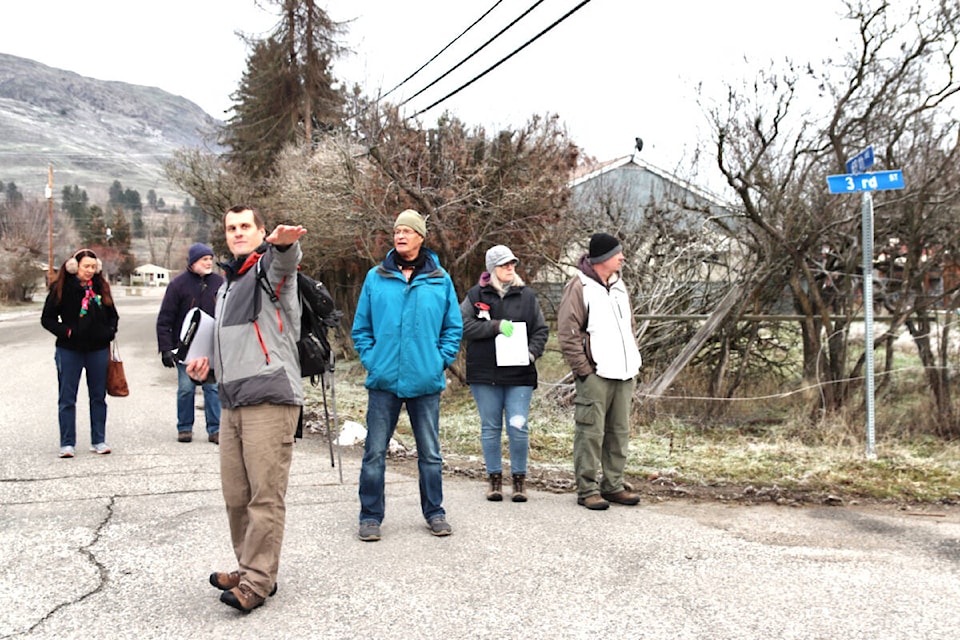Demolition along the North Ruckle dike alignment is slated to begin within the next six weeks, according to Graham Watt, City Hall’s Manager of Strategic Initiatives and Flood Recovery.
Watt said homes in the way of the dike will come down first. Surrounding homes, dozens of which are now up for bid, will start to come down in the weeks after bidding closes on Jan. 31, with homes bought by private investors to be moved to other communities after April 1.
READ MORE: Dozens of Grand Forks homes up for bid, to be removed ahead of DMAF construction
READ MORE: City to partner with First Nation in housing development
Watt explained the schedule during a public tour of North Ruckle Friday, Dec. 3, when city residents were invited to tour the neighbourhood destined to become a naturalized floodplain. The city bought most North Ruckle homes after the low-lying area was inundated by a “once-in-200-year-flood” in the spring of 2018, he said.
The unbuilt dike is designed to protect the city’s wastewater treatment plant and nearby Interfor and Rockwool plants from future flooding. The floodplain will be stripped of all permanent dwellings, allowing the Kettle River to wax and wane without damaging property or threatening human life.
The city said last spring that the homes would be demolished starting in mid-summer, at which point their utilities were to be removed as well. Watt said this was delayed until the city could buy homes from residents who chose not to participate in the buy-out program, two of whom are still living in North Ruckle.
Watt said the city’s ongoing expropriation processes, which will give holdouts fair market value for their homes, plus the value of post-flood repairs, added a minor delay. Demolition has been hindered to this point largely owing to logistical challenges between the city, which provides water, sewer and electrical utilities to the area, and other utility providers, including the natural gas supplier FortisBC and the telecoms company, Telus.
“It takes a while to work through the plans together. With joining the projects and bundling them together, it was basically better to delay it,” Watt told The Gazette.

Among the tour group, Muriel Neale, who had to sell her home in South Ruckle ahead of a separate dike, said the city has handled its flood work projects reasonably well.

“They’ve done the best they could,” she sighed, adding, “I like everybody I dealt with on the city’s end.”
“Armchair hydrologists” have said otherwise, talking up their own projects Neale said were naive at best. She would know, having followed all of the city’s information sessions about how the upcoming flood works will protect Grand Forks.
“So many people have said, ‘Well, the city should do this, this, this and that,’ and I just say, ‘No. I know so much more about this than you,” and I have to walk away.”
Of the city’s five major flood works, paid for by roughly $51.5 million in provincial funding and the federal government’s Disaster Mitigation and Adaptation Fund (DMAF), Watt said only the 19th Street Erosion Control project in Johnson Flats has been completed. The rest have made for a mammoth undertaking on behalf of the five city staff in charge of the DMAF projects, two of whom work on a steady, full-time basis.
“A lot of local governments don’t have enough capacity” for flood mitigation, Watt said. Even if they had, DMAF’s underlying engineering projects and complicated permitting process — across at least four agencies between the provincial and federal governments — were always going to take time. Then there are referrals to local First Nations, some of whom are known to have archaeological interests in North Ruckle.
Meanwhile, highway reconstruction and flood recovery efforts across southern B.C. could impact DMAF timelines, given that all of these projects will draw on the same pool of available construction materials and industry players.
“Our team is working with suppliers to see if there’s going to be an impact on that availability,” Watt said.
Declining to go into specifics before a more detailed report goes before city council Monday, Dec. 13, he broadly acknowledged that, “Looking at the size of repair projects elsewhere in the province, it’s definitely something that we to understand how it might impact us.”
*Editor’s note: A previous version of this story indicated that the city’s Land Acquisition Program gave eligible homeowners “pre-flood market value” for their homes, plus the value of post-flood repairs. This was not accurate. Instead, homeowners were given “fair market value” for their homes, plus the value of post-flood repairs, according to Graham Watt.
@ltritsch1
laurie.tritschler@grandforksgazette.ca
Like us on Facebook and follow us on Twitter.
laurie.tritschler@boundarycreektimes.com
Like us on Facebook and follow us on Twitter.
